Pepperoni sticks are a great introduction to air-drying cured meat at home. The process is very quick and very forgiving: even if you don’t have a whiz-bang curing chamber with perfect temperature and humidity control, you can probably make these pepperoni sticks at home and be very pleased with the result. And if for some reason you are worried that the whole process has gone sideways, just hot-smoke them or cook them and they will still be delicious. This is one of the recipes we make in my More Charcuterie at Home class, which is all about curing and air-drying meats.
These are meant to emulate the pepperoni sticks you get at gas station convenience stores. The recipe was developed … Continue reading.
This post was originally published on December 3, 2010. Re-posted today for Eat Alberta. I chose buffalo jerky for this year’s Eat Alberta tasting board because of the significant role that similar preparations played in the history of this province. Please read The Story of the Buffalo for more information.
 Jerky is my nominee for best representation of southern Alberta by a single food preparation. This is partly because of its historical connection to the buffalo hunt and ranching, but also because it takes advantage of the arid landscape. In dry regions jerky can safely be made on hot days, when the temperature is around 30°C, simply by leaving the sliced meat to hang outside.[1]
Jerky is my nominee for best representation of southern Alberta by a single food preparation. This is partly because of its historical connection to the buffalo hunt and ranching, but also because it takes advantage of the arid landscape. In dry regions jerky can safely be made on hot days, when the temperature is around 30°C, simply by leaving the sliced meat to hang outside.[1]
What Meat to Use.… Continue reading.
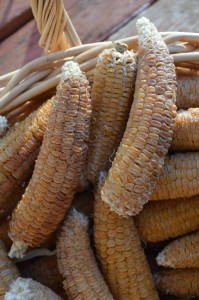 My bid for Bartlett’s: “Culinary invention has two mothers: scarcity and excess.”
My bid for Bartlett’s: “Culinary invention has two mothers: scarcity and excess.”
I think everybody understands how scarcity can encourage adventurous eating. We often say that the first man to eat a lobster, or an oyster, was a brave one, indeed. But it’s when you find yourself with an overwhelming surfeit of food that you can start doing really interesting things. The first person to press grapes to make wine must have had a lot of grapes, more than he could have eaten before they started rotting. And the first person to distill wine to make brandy must have had an awful lot of awful wine.
I wrote earlier in the fall of our bountiful corn harvest, and of … Continue reading.
Air-dried beef goes by many different names in many different places. The most famous, I think is bresaola, from northern Italy. In adjacent Switzerland air-dried beef is pressed into a unique block shape and called Bündnerfleisch, after the Swiss canton of Graubünden. Nearby in eastern France it is often lightly smoked, and called brési. In all of these alpine regions it is a common accompaniment for fondue.
Eye of round is one of the best cuts to use for air-dried beef. It is a single muscle, with very little internal fat, easily trimmed to a convenient size. First remove any silverskin and fat.
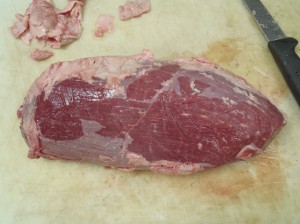
The cleaned eye of round:
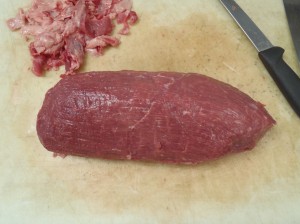
The clean muscle is then rubbed with salt, … Continue reading.
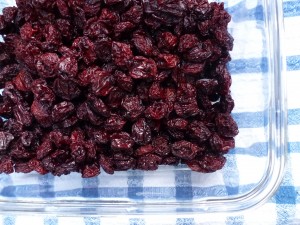 Most sour cherry varieties, like Evans, do dry okay, but it takes forever. With my dehydrator running on the “Fruit/Vegetable” setting (135°F), it took 30 hours to reach raisin consistency.
Most sour cherry varieties, like Evans, do dry okay, but it takes forever. With my dehydrator running on the “Fruit/Vegetable” setting (135°F), it took 30 hours to reach raisin consistency.
The dried cherries are extremely sour, even more so than when fresh (which I should have anticipated…)
I had originally planned to eat these dried sour cherries in yogurt and granola, but they are way too tart to be consumed with tangy yogurt. Suggested alternative uses: game terrines, “Raincoast Crisp” style cracker, and other applications where there is meat or starch to temper their acidity. I also love tossing them into puddings, like wild rice and barley.
When dry-curing, mold is inevitable, yet there’s little detailed information available to guide the beginner. I don’t know for sure why this is, but I have some theories:
- mold is so variant and hard to describe,
- mold-discussions might disgust customers, and
- mold is a mystery of the charcutiers’ cult.
The general rule in charcuterie is that smooth, hard, white mold is “good.” I don’t think it affects the flavour of the meat in any way, but it discourages the growth of “bad” mold, that is, mold that is pathogenic or that somehow compromises the meat. Any type of fuzzy mold is said to be bad.
Luckily, undesirable mold can simply be cut away; it doesn’t taint the entire batch of … Continue reading.
When I first decided to make pemmican, I thought the process would be simple: make jerky, pound jerky, render fat, combine. In practice, there were a couple hiccups, but the results were surprising.
In the finest pemmican, the dried meat was pounded until it became a powder. I started grinding pieces of jerky with a mortar and pestle. It worked, but I realized it would take days to process a useful quantity of meat. I eventually found a rock and a solid piece of earth, wrapped the jerky in cloth and pounded it out. You could probably blitz the meat in a food processor and obtain similar results.
With my meat powder made, I ran into a problem:
Buffalo Fat
…
Continue reading.
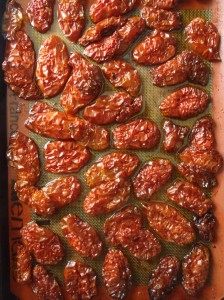 Two years ago, I had no place in my heart for tomatoes. With the stiff, pale burger-garnishes in mind, I wondered how anyone could get excited about them.
Two years ago, I had no place in my heart for tomatoes. With the stiff, pale burger-garnishes in mind, I wondered how anyone could get excited about them.
Then a few potted tomato plants in the backyard taught me how much heat they need to mature. Once they started to fruit, the woman next door was in awe, as not thirty feet away she had tried to grow tomatoes to no avail. We decided it was the exposed, south-facing cement wall behind my plants, storing heat during the day to pass to the tomatoes at night, that let them flourish. After harvest, I built a special room in my heart for tomatoes, the demanding plants that grow best in greenhouses … Continue reading.
 I just finished my first batch of dry-cured sausage. It is essentially fresh ground pork, stuffed into casings with nitrate and seasonings, then left to dry. The temperature and humidity have to be just right for the sausage to dry properly. I experimented with climate-control when making pancetta this past spring. In that case the meat had already been cured in my fridge, and the drying was just to change the texture. The pancetta was also cooked before eating. This is a whole other ball game, as these sausages aren’t cured in the fridge beforehand, and aren’t cooked before eating.
I just finished my first batch of dry-cured sausage. It is essentially fresh ground pork, stuffed into casings with nitrate and seasonings, then left to dry. The temperature and humidity have to be just right for the sausage to dry properly. I experimented with climate-control when making pancetta this past spring. In that case the meat had already been cured in my fridge, and the drying was just to change the texture. The pancetta was also cooked before eating. This is a whole other ball game, as these sausages aren’t cured in the fridge beforehand, and aren’t cooked before eating.
Dry-curing is an interesting process. With most charcuterie preparations, there are easily-described visual indicators to guide you along. For instance, … Continue reading.
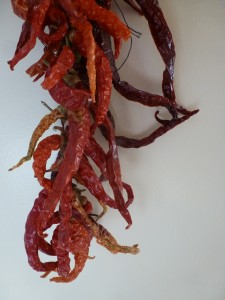 We didn’t eat spicy food when I was growing up. Not at all.
We didn’t eat spicy food when I was growing up. Not at all.
I didn’t learn to appreciate spicy food until I was in my early twenties, and it was at an Italian restaurant, of all places. I patronized Mercato in Calgary throughout high school, then later I had the opportunity to work in their kitchen. They make food from all over Italy, but the owners are Calabrian, and there’s always a few pastas on the menu made by infusing olive oil with garlic and hot chili flakes. I remember the first time that I realized how effective a little heat can be. It wakes up your mouth, and it elongates the sensation of the dish, as your mouth is … Continue reading.
The personal website of Edmonton chef Allan Suddaby








 We didn’t eat spicy food when I was growing up. Not at all.
We didn’t eat spicy food when I was growing up. Not at all.